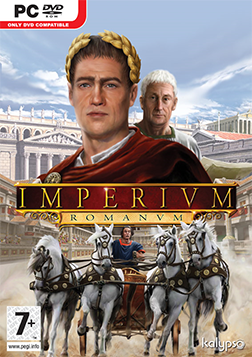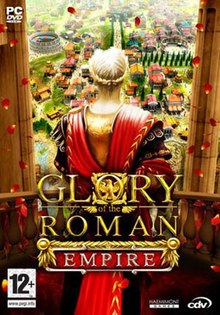
Dark Reign: The Future of War is a real-time strategy video game for Microsoft Windows, developed by Auran and published by Activision in 1997. The game consists of a large single-player campaign but also supports multiplayer online games. A mission construction kit is included with the game, which allows players to create new maps for multiplayer games and create entire missions and campaigns.

Nexus: The Jupiter Incident is a science fiction themed real-time tactics computer game developed by the Hungary-based Mithis Entertainment and published by HD Interactive. The game focuses on tactics and ship management instead of resource collection and base construction.

Star Wars: Empire at War is a 2006 real-time strategy video game developed by Petroglyph Games and published by LucasArts for Microsoft Windows and Mac OS X. Set between Episode III and Episode IV, it focuses on the fledgling struggle between the Empire and the Rebels. It uses Petroglyph's game engine Alamo. In October 2006, an expansion titled Star Wars: Empire at War: Forces of Corruption was released. On May 31, 2014, online functionality, including network multiplayer and wireless chat, was discontinued after Glu Mobile's purchase of GameSpy and the subsequent shutdown of all game servers. As of September 1, 2017, the multiplayer has been re-enabled on the Steam version with Workshop support added.

A Roman circus was a large open-air venue used mainly for chariot races, although sometimes serving other purposes. It was similar to the ancient Greek hippodrome. Along with theatres and amphitheatres, circuses were one of the main entertainment venues at the time.

The Settlers II, originally released as The Settlers II: Veni, Vidi, Vici, is a city-building game with real-time strategy elements, developed and published by Blue Byte Software. Released in Germany for DOS in April 1996, and in the United Kingdom and North America in August, it is the second game in The Settlers series, following The Settlers (1993). In December, Blue Byte released an expansion, The Settlers II Mission CD, featuring new single-player campaign missions, new maps for both single-player and multiplayer modes, and a map editor. In October 1997, they released The Settlers II: Gold Edition, containing the original game, plus the Mission CD expansion, along with minor graphical enhancements and gameplay tweaks. The Gold Edition was also ported to Mac OS in 1997. In 2006, an enhanced remake, The Settlers II , was released for Microsoft Windows. In 2007, the Gold Edition was ported to the Nintendo DS, under the title The Settlers, released in Germany in July, and in the United Kingdom and North America in August. Although adapted for the dual-screen display of the DS, and with controls specifically programmed for use with the DS stylus, the gameplay, game mechanics, graphics and storyline are unaltered. In 2009, the original Gold Edition was released on GOG.com, and in 2018, it was re-released for Microsoft Windows as The Settlers II: Veni, Vidi, Vici - History Edition.

CivCity: Rome is a city building strategy game by Firefly Studios and Firaxis Games. It includes elements from two game series, Caesar and Civilization.

The Settlers II is a city-building game with real-time strategy elements, developed by Blue Byte and published by Ubisoft. Released for Microsoft Windows in September 2006, it is a remake of The Settlers II (1996). In March 2007, Blue Byte released a German-language expansion, Die Siedler II: Die nächste Generation - Wikinger, featuring new single-player campaign missions, new maps for both single-player and multiplayer modes, a random map generator, and minor gameplay tweaks. In September 2008, they released Die Siedler: Aufbruch der Kulturen, a spiritual successor to Die nächste Generation. In 2013, the original 10th Anniversary game was released on GOG.com.

Panzer Elite Action: Fields of Glory is a video game, developed by ZootFly and published by JoWooD Productions. It was released in Europe in 2006, but was not released in North America.

Celtic Kings: Rage of War is a game developed by Haemimont Games. It is set during the conquest of Gaul by Julius Caesar.

Colonia Claudia Ara Agrippinensium was the Roman colony in the Rhineland from which the city of Cologne, now in Germany, developed.

Jagged Alliance 3 is a tactical role-playing video game developed by Haemimont Games and published by THQ Nordic. The game was released for Windows on July 14, 2023. The game was also released for PlayStation 4, PlayStation 5, Xbox One and Xbox Series X/S on November 16, 2023. It is the first mainline entry in the Jagged Alliance series since Jagged Alliance 2 (1999).

Imperium Romanum is a 2008 city-building video game for Windows developed by Haemimont Games and published by Kalypso Media. Imperium Romanum is a sequel to the 2006 game Glory of the Roman Empire, by the same developer. Players act as governor of a Roman province and must build and maintain a thriving and prosperous settlement. The game takes place during the time of the Roman Empire. Players build Roman towers, gates, and bridges and use currency to fund projects. The Italian and Spanish versions of the game are titled Imperivm: Civitas II.

Grand Ages: Rome is a 2009 city-building and real-time strategy game developed by Haemimont Games and published by Kalypso Media. It is the sequel to 2008's Imperium Romanum. The Italian and Spanish versions of the game are titled as Imperivm: Civitas III. A sequel, Grand Ages: Medieval, was released on September 25, 2015.

Tropico 3 is a video game developed by Haemimont Games and published by Kalypso Media. Like the previous games in the series, Tropico 3 is a construction and management simulation as well as a political simulation game, with emphasis on city building. As a thematic sequel to Tropico, the game attempts to return to the roots of the series, which puts the player into the shoes of "El Presidente" – a ruler governing over an island banana republic.

Age of Empires (AoE) is a real-time strategy video game based on history, developed by Ensemble Studios and published by Microsoft, and the first game in the Age of Empires series. The game uses the Genie Engine, a 2D sprite-based game engine. The game allows the user to act as the leader of an ancient civilization by advancing it through four ages, gaining access to new and improved units with each advance.
Ordo Urbium Nobilium is a Latin poem in dactylic hexameter by Decimus Magnus Ausonius. It was written after a journey Ausonius took through the Roman Empire between the years 388 and 390 CE. The poem lists brief descriptions of the major cities of the Roman Empire and ranks them from the most important to the least important.

Star Citizen is an in-development multiplayer, space trading and combat simulation game. The game is being developed and published by Cloud Imperium Games for Windows. An extended retry of unrealized plans for Freelancer, Star Citizen is led by director Chris Roberts. The game was announced via a private crowdfunding page in September 2012, followed on October 18, 2012 by a successful Kickstarter campaign which drew over US$2 million. Pre-production of the game began in 2010, with production starting in 2011.

Battlefleet Gothic: Armada is a real-time tactics video game developed by Tindalos Interactive and published by Focus Home Interactive. It is set in the fictional universe of Warhammer 40,000, and is specifically an adaptation of the miniature wargame Battlefleet Gothic by Games Workshop.

Nemesis of the Roman Empire is a real-time strategy role-playing video game developed by Haemimont Games and published by Enlight Software. The sequel to Celtic Kings: Rage of War, the game is set in the Punic Wars and allows the player to take control of one of four nations, as well as Hannibal the Great.

Surviving Mars is a city building survival video game initially developed by the Bulgarian studio Haemimont Games, and later by Abstraction Games, and published by Paradox Interactive. It was released on Microsoft Windows, macOS, Linux, PlayStation 4 and Xbox One on March 15, 2018. The player serves as an overseer who must build a colony on Mars and ensure the survival of the colonists. A spiritual successor, Surviving the Aftermath, was released in 2021.



















